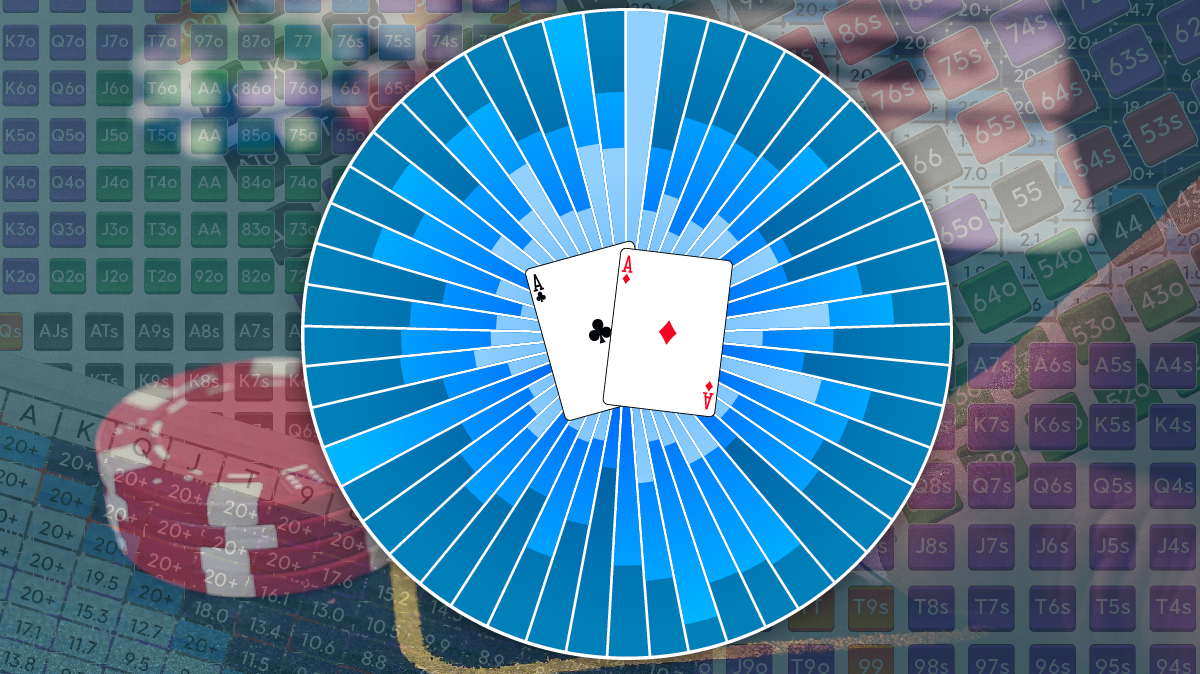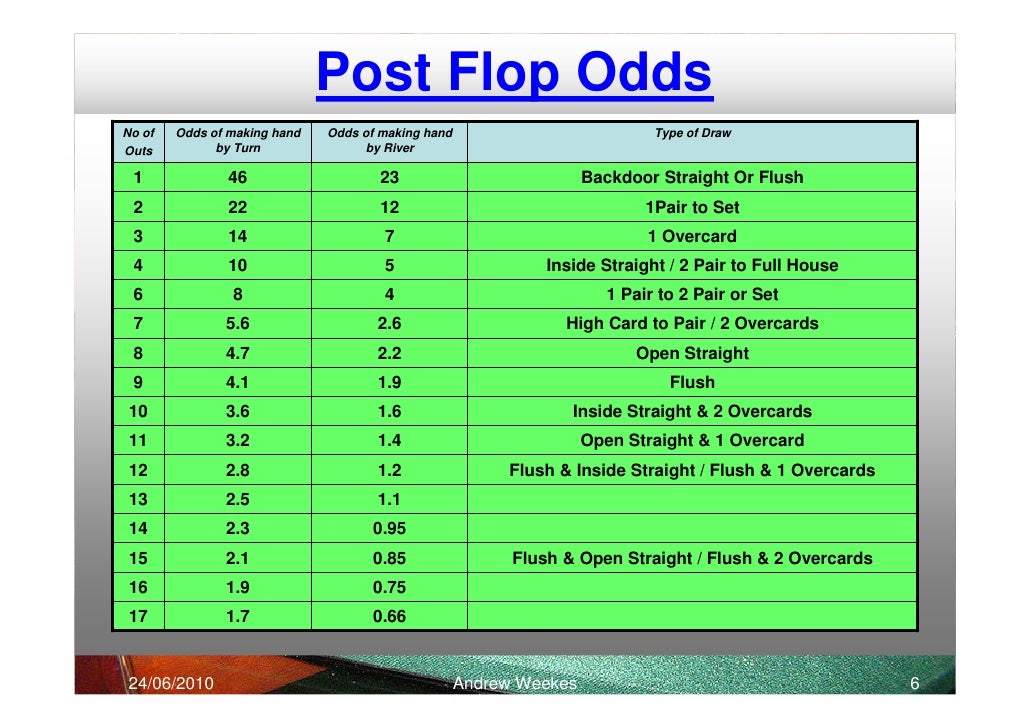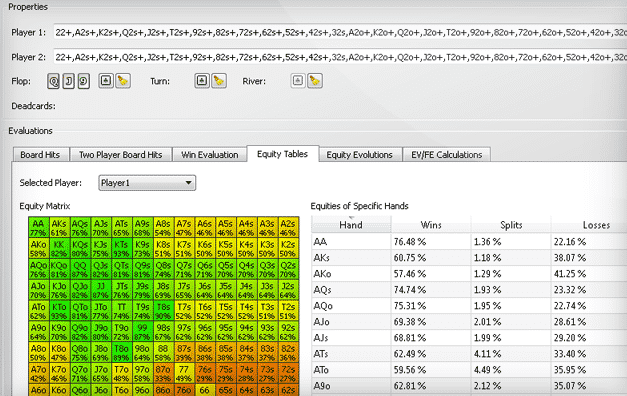Betting before the flop can sometimes be a blind bet, because when the flop comes things can change drastically. What can seem like a clear advantage can turn into a trap when the Turn or River or Flop cards hit the poker games.
On this site you can find all possible combinations of preflop hands that can occur in Texas Hold'em Poker. As a bonus you will also learn the nicknames of the different hands. The hands are ranked from #1 to #169, where #1 is the best. This ranking is applicable when the poker table is full ring (9-10 people). Texas Holdem Heads-Up Preflop Odds. This table was created by enumerating through every possible board and opponent hole card combination for each of the 169 texas holdem preflop starting hands.
To calculate with which hand you have better chance against other hands, we have assembled the most common grouping of hands against other hands along with their chances of winning (all the way to the River).
Same Hand – ex. QJ vs. QJ
Can you guess the odds? That's right, 50%-50%. If it's suited vs. offsuit, the suited has the edge of course, a 2.5% advantage.
Pocket Pair vs. Two Overcards – ex. 99 vs. KQ
This is a close call. The pocket pair has a small advantage with 55 % to the two overcards' 45%. In the case of having a hand like QJ-suited the advantage is with this hand over a hand with a small pocket pair (55 or lower), because with the QJ you can still form a Straight without having the pair lower your chances of achieving it.
Pocket Pair vs. Smaller Pocket Pair – ex. AA vs. 88

The bigger pair has the advantage here, of course, with 80% to the lower pair's 20%.
Pocket Pair vs. Two Undercards – ex. KK vs. J9
The pair is the favorite with 80% to 20%. The two undercards have a chance of between 23% and 14%, depending on if they are suited and if the pocket interferes with their straight making ability or not.
Pocket Pair vs. Same Card & One Undercard – ex. KK vs. KQ
This can be a shifty situation. The Pocket Pair has the upper hand here (no pun intended) with about 85% to 15%, while in case the other pair is suited the odds change to 80% to 20% at best.
Pocket Pair vs. Same Card & One Overcard – ex. QQ vs. AQ
The advantage here is on the side of the pair with between 70% to 30% and 65% to 35%.
Pocket Pair vs. One Undercard & One Overcard – ex. JJ vs. KT
The odds here are similar to those of the hands above, with 70% to 30% in favor of the pair.
Two Undercards vs. Two Overcards – ex. AK vs. QJ
While the advantage here is clearly with the overcards – 65% to 35%, the odds change when the undercards are far enough from the overcards and suited without matching the overcards' suit, to around 60% to 40%.
Two Middle Cards vs. Undercard & Overcard – ex. KT vs. QJ
In this case, the edge is with the over/under cards. 60% to 40% which can be reduced to around 52% to 48% if it involves middle-suited connectors that are not of the same suit as the over/under cards and if there is no straight making interference.
Dominated with the Same High Card – ex. QJ vs. QT
Do Poker Odds Change With More Players?Absolutely. The More Players Involved In A Pot, The Less Your Chances Of Winning It. That's Why It May Make Sense To Shove Pre-flop With Certain Ha...
The hand with the higher card has a big advantage with around 66.6% to 33.3%. This advantage starts to diminish as the kickers get lower due to split pot possibilities.

Dominated with the Same Low Card – ex. AQ vs. KQ
The hand with the higher card has a 66% advantage, while if it's a suited connector against unsuited cards that has a small chance of making a straight the higher kicker hand has a maximum advantage of 40%.
In this lesson we’re going to run through a number of heads-up match-ups that will help give you an idea of where you stand in a variety of pre-flop situations when playing hold’em. Be aware that we’re only going to focus on individual hand match-ups. When playing hold’em it’s essential that you put your opponent on a range of hands, rather than specific holdings. However, knowing the odds of common pre-flop match-ups is a good starting point. Pick out and study what will help you. While it’s not essential that these statistics be committed to memory, it won’t hurt you if you do.

Let’s start by looking at hand match-ups when holding a pair:
Pair vs. Pair
The higher pair is an 80 percent favourite. We can get very technical and highlight the fact that if the underpair didn’t have any clean suits and/or the maximum number of straight outs then the high pair’s equity would increases by one or two percent.
Pair vs. Overcards
This is the classic coin flip hand that you’ll see many times late in tournaments with one player being all-in. The term coin flip indicates an even money situation which is really a 55 to 45 percent situation, as the pair is a slight favourite.
Pair vs. Undercards
In this situation the pair is normally about a 5-to-1 favourite and can vary depending on whether the two undercards are suited and/or connectors.
Pair vs. Overcard and an undercard
The pair is about a 70 percent favourite. Another example of this holding would be J-J against A-9. The underdog non-paired hand has three outs while the favourite has redraws.
Pair vs. Overcard and one of that pair
The classic example of this situation is the confrontation between a pair of cowboys and big slick. The A-K has three outs and it becomes a 70-30 percent situation or a 2.3-to-1 dog for the cowboys. This is a far cry from the next situation where even though one of the pair is matched the other card is lower.
Pair vs. Undercard and one of that pair
The non pair has to hit its undercard twice or make a straight or flush to prevail. The pair is better than a 90 percent favourite or slightly better than 10-to-1 odds. I’ll take those odds anytime.
Pair vs. Lower suited connectors
You see this match-up late in tournaments when a player is getting desperate and pushes all-in with middle suited connectors. A hand such as Q-Q against 7-6 suited would be a prime example. The pair is a strong favourite to win.
Pair vs. Higher suited connectors
Here is the real coin flip situation. A pair of eights heads-up against a suited Q-J is a fifty-fifty proposition. The higher suited cards would have an edge against a lower pair, such as 2’s or 3’s, since the board itself can sometimes destroy little pairs.
Common Pre-Flop Match-Ups (Non Pairs)
The following heads-up confrontations contain no pairs.
Two high cards vs. Two undercards
The two higher cards are usually a 65% favourite to win, but it can vary depending on whether any of the cards are suited and/or connectors.

High card, low card vs. Two middle cards
In this match-up the high card gives it the edge. But it’s only a marginal winner, approximately 57% to the hand containing the high card.
High card, middle card vs. Second highest, low card
The edge is increased by around 5% when the low card becomes the third highest card, as shown in this example, which gives approx 62% to 38% for high card/middle card combination.
High card, same card vs. Same card, low card
In this example the A-J is in a very strong position. If we discount any flush or straight possibilities, it only leaves the player holding J-8 with three outs (the three remaining 8’s).
Same high card, high kicker vs. Same card, low kicker
The high kicker gives this hand a fairly big edge. It’s very common for A-K run into A-Q, A-J, and lower, and it’s why Ace-King is such a powerful hand, particularly at the business end of no-limit hold’em tournaments when people move all-in with any sort of Ace.
Statistical Variations
For any math maniacs reading this who do not find these odds precise enough, I acknowledge that the math is rounded and for the most part does not take into account the possibilities of ties and back door straights and flushes. What players need to be equipped with is the general statistical match-up – not the fact that in the example of a pair of eights against a suited Q-J the percents are exactly 50.61 for the eights to 48.99 for the suited connectors with the balance going to potential ties. I call that a fifty-fifty proposition.
Of greater importance than quibbling over tenths of a percent is the fact that in most heads-up confrontations you can never be a prohibitive underdog. That is one reason why poker is so challenging and fun. Of course, while true, I’m not attempting to embolden the reader to ignore the odds and become a maniac. Math is the underpinning of poker and if you regularly get your money into the middle with the worst of it you will go broke.
One statistic that hasn’t been mentioned, and it’s one that I particularly like is this – the odds of both players being dealt Aces when playing heads up (one on one) is 270,724-to-1. It’s my favourite statistic because it provides me with almost total confidence when I’m playing heads up and receive pocket Aces that I’m the boss! That confident feeling lasts right up to the river when my Aces get cracked by some rotten piece of cheese which my opponent elected to play. As mentioned already, rarely are you a prohibitive underdog – so remember that to keep those losing hands in perspective.
Related Lessons
By Tom 'TIME' Leonard
In Poker, What Are Pot Odds?Pot Odds Refers To The Relationship Between The Size Of The Pot And The Size Of The Bet. For Example: If There's $10 In The Pot And You Have To Cal...
Tom has been writing about poker since 1994 and has played across the USA for over 40 years, playing every game in almost every card room in Atlantic City, California and Las Vegas.